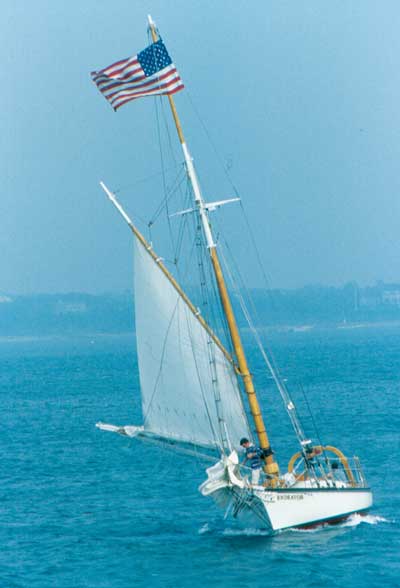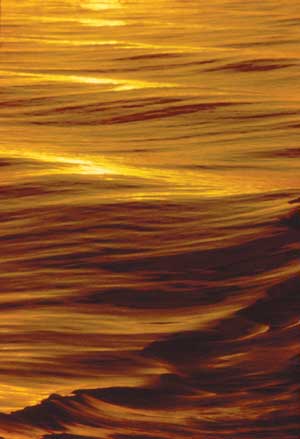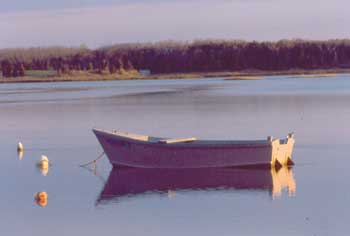by Christine Ridout
Photos by Budd Titlow
Summer is almost here and it’s time to drag the sailboat from the garage
or get it out of drydock. Sailboats give us access to beautiful and isolated
places. The Midwest's lakes and rivers, its coves and inlets, and wide-open
water are home to a wide variety of waterfowl and songbirds. At water’s
edge, otter, deer, and wading shorebirds are common sights. Small islands
abound, villages are scenic, sleepy. The infinite stretches of blue—both
water and sky—render us insignificant. Other boats, particularly sailboats,
create postcards in our minds. How can we capture these warm summer
memories? How can we describe to our friends where we’ve been, what we’ve
seen? How, on a cold winter night, can we recreate these images in our mind?
Photographs. But photography from a boat is a struggle. How many shots fail
to catch the majesty of the distant sailboat because it is a speck amidst
sky and water? How many wildlife photos are blurs because the motion of the
boat made sharp focus impossible? How many of those scenic villages aren’t
so scenic because a crucial element of the composition was omitted? Too
many!
But there are tricks to boat photography that give us photos that capture
what we saw and felt. A big issue in boat photography is composition.
Because photos from a boat are most often taken from a distance, they tend
to encompass too much blank water and sky. Blank space diverts attention
from the subject, fails to convey a mood, and is extremely boring. To create
interest, photos need balance. This can be done with either a strong
foreground, such as a catamaran racing across the water with the wind, or a
strong background—rainbow-punctuated storm clouds would probably do.
A second trick to eliminating blank space is to add foreground framing, such
as the boat’s rigging, a portion of the boat itself, or objects on the boat.
Sometimes, the rigging itself is an interesting photo. Blank space can also
be limited by using a telephoto lens that allows you to focus closely on
your subject. Fill the frame with the heron, the canoe, the deer, the small
village, the sailboat.
Telephoto zoom lenses in the 70-210mm or 100-300mm ranges are also useful
because they help overcome limited maneuverability. On a boat, it is not
possible to walk or drive to a position that gives you the best
compositional angle. Telephoto zoom lenses compensate by enabling you to
eliminate undesirable elements in the composition and compose tight graphic
shots of villages, wading shore birds, and boats in the distance. Also, with
telephoto lenses, depth of field is not an issue because you’re focusing
closely on a single object, omitting the background. This enables you to use
wider apertures and faster shutter speeds to compensate for the motion of
the boat. And, if you focus carefully, the dock on the point will be just as
sharp at f4 as at f16.
The second problem in boat photography is motion. On land, tripods solve
this problem. But on water, the tripod is on the moving boat. So leave your
tripod onshore and use a fast shutter speed of a least 1/500 and fast
film---ASA 200 slide film or faster if you shoot prints. The fast shutter
speed freezes action and compensates for the motion of the boat. Open the
lens to its widest aperture (the lowest f/stop number) in order to increase
shutter speed. Although depth of field will be reduced, shallow depth of
field will not be a problem if the subject is surrounded by water and sky.
Next, brace yourself as best you can: spread your feet widely, tuck arms
tightly to the body. Take a deep breath, relax, and gently release the
shutter. Also, keep arms free as opposed to bracing them on the boat. Any
part of your body which touches the boat will transmit motion and to the
camera. As you get the hang of it, you can use your legs as shock absorbers
to buffer the boat’s motion.
Proper exposure is also tricky from a boat: the boat is always moving in
relation to the sun and the light is constantly changing. To ensure the best
lighting on your subject, be ready and able to move around the boat easily.
If there's an upper deck, it will allow you to change sides without running
around the cabin.
Water can also create exposure problems because it tends to be darker than
middle tone (a gray card). To compensate, set exposure to –0.5 and then
shoot a three-stop bracket around it (-1.0, -0.5, auto). In extreme lighting
conditions, such as strong highlights off the water, use a five-stop bracket
around the auto-exposure setting (-1.0, -0.5, auto, +0.5, +1.0) for each
composition. This will ensure at least one proper exposure as the sun dances
on the water’s surface.
A motor drive is another must for boat photography, particularly when
shooting other moving objects such as deer or waterfowl. A motor drive
allows you to shoot continuously, enabling you to capture wildlife at the
height of action. A motor drive is also important even when shooting
stationary shore scenes. The barn by the river may not be moving, but the
boat is. This means your perspective is constantly and rapidly changing and,
once you’ve passed the best compositional angle, you won’t have a chance to
try again. A motor drive helps capture the best view the first time you sail
by.
Wildlife photography can be particularly rewarding from a boat. Since you’re
“in the same element” as your subjects, you are less threatening and
wildlife tends to be more receptive, less skittish about your presence—they
may even ignore you or, perhaps, be curious and come closer to get a better
look at you! When photographing wildlife, knowing something about their
habits is helpful. Be sure, for example, that you’re just offshore when the
warming sunrise awakens a bird colony or deer come to water's edge to drink.
With a little knowledge, your wildlife photos will be knockouts.
For pure fun and potentially unique photos, try photographing just the
water. Water with interesting reflections, wave action, or unusual lighting
patterns creates photos that resemble abstract designs. This is often most
true at sunrise or sunset, when the light slants off the water rather than
bouncing off it with such intensity. For a variety of abstract effects, vary
shutter speeds from 1/15 to 1/1000 second.
Finally, effective boat photography requires concentration and anticipation.
On a moving boat, perspective is constantly changing. The farmhouse that was
too far away suddenly becomes the perfect background when a sailboat swoops
around the point. The fishing boat that was in deep shadow a minute ago,
swings broadside into perfect light. If you’re anticipating, you’ll get both
shots. If you’re not, you’ll see the compositions too late to trip the
shutter. And on a boat, you can’t walk back and try again.
But, you can vacation again—with your photos.
* * * * * * * * * * * * * * * * * *
Christine Ridout is a freelance writer and director of the BostonWest Center
for Writing and Photography in Wayland, MA. Her website can be found @
www.thewritephoto.com


